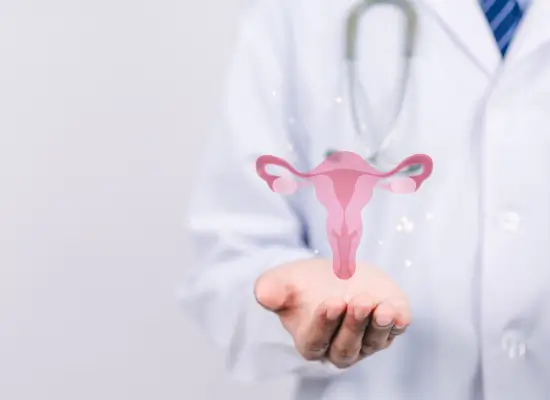Uterine Fibroid Embolization is a minimally invasive procedure that treats uterine fibroids by cutting off their blood supply.

- Synopsis
- Introduction
- What is Uterine Embolization?
- Types of Uterine Embolization
- Why Choose Uterine Embolization?
- Preparation for Uterine Embolization
- Uterine Embolization Procedure
- Recovery and Aftercare
- Risks and Complications After Uterine Embolization
- Why Choose Gleneagles Hospitals for Uterine Embolization?
Synopsis
Uterine embolization is a minimally invasive procedure that is used to treat uterine fibroids by shrinking them. Uterine Fibroid Embolization in Bangalore is performed by experienced interventional radiologists who use a catheter to deliver small embolic agents to the arteries that supply blood to the uterine fibroids. Gleneagles Hospital is regarded as one of the top hospitals in Bangalore to perform this procedure with the utmost safety measures and a high success rate.
Introduction
Uterine Fibroid Embolization is a minimally invasive therapy to treat uterine fibroids that is a great alternative to major surgeries like hysterectomy or myomectomy. During the procedure, a catheter is inserted through the blood vessels in the leg or the wrist and is guided by fluoroscopic images to deliver tiny particles that stop blood flow to the uterus. Since the blood flow to the fibroid is blocked, it shrinks gradually over time. According to Penn Medicine, this procedure has a success rate of 85%. This treatment is recommended for patients who are symptomatic from their fibroids and wish to avoid major surgeries.
What is Uterine Embolization?
Uterine Fibroid Embolization is a nonsurgical and minimally invasive procedure for uterine fibroids that aims to preserve your uterus. This procedure has lower complications and reduced risk factors. Since the procedure is minimally invasive, the recovery period is swift, with most patients being able to get back to regular activities within a week. Patients should discuss their eligibility with the doctor before making any decision, as patients with active pelvic infections, uncorrectable bleeding problems, endometrial cancer, and extremely large fibroids are not the ideal candidates for the procedure.

Types of Uterine Embolization
There are several types of uterine embolization that are designed to treat specific types of conditions, such as fibroids, adenomyosis, and postpartum haemorrhage. Here are some common types of uterine embolization:
- Uterine Fibroid Embolization (UFE): This procedure is great for treating symptomatic uterine fibroids by blocking the blood supply to the fibroid tissues, causing them to shrink over time. It is performed by injecting embolic agents into the uterine arteries. It reduces various symptoms like heavy bleeding, pain, and pressure.
- Uterine Artery Embolization (UAE): It is a broader term that includes procedures like UFE. It injects embolic agents into the uterine arteries and cuts off blood supply to abnormal tissues.
- Postpartum Hemorrhage Embolization (PHE): This is performed in cases of severe postpartum bleeding that does not improve with medications and other conventional treatments. The procedure selectively embolises bleeding arteries to control life-threatening haemorrhages and preserve fertility.
- Adenomyosis Embolization: This procedure targets abnormal endometrial tissue growth in the uterine muscle. It reduces heavy menstrual bleeding and pain associated with adenomyosis.
Your health matters – get expert advice today.
Why Choose Uterine Embolization?
Uterine Fibroid Embolization in Bangalore offers a viable alternative to major surgeries like hysterectomy or myomectomy. It treats symptomatic uterine fibroids in a minimally invasive manner that preserves the uterus and reduces symptoms associated with fibroids. Here are some common cases when uterine embolization is needed:
- Uterine Fibroids: Uterine embolization is used to manage fibroids that are causing symptoms like pain, vaginal bleeding, and other related issues.
- Adenomyosis: Uterine embolization effectively treats adenomyosis. It is a specific medical condition where the inner lining of the female’s uterus breaks through the muscular walls of the uterus, causing heavy and painful menstrual bleeding.
- Postpartum Hemorrhage: Uterine embolization is a commonly used method to control excessive postpartum bleeding by blocking the blood vessels leading to the uterus.
Preparation for Uterine Embolization
Patients must prepare for Uterine Fibroid Embolization in Bangalore for a safe and smooth procedure.
- Medical Evaluation: You will need to consult the interventional radiologist, who will discuss your symptoms, medical history, & possible treatment options. You will be recommended imaging tests, blood tests, and a pregnancy test to fully assess every aspect of your condition.
- Medications & Pre-Procedure Instructions: You will need to stop blood thinners for a certain period before the procedure to avoid complications. The doctor will discuss medication and a post-procedural pain management plan with you ahead of the embolization. Some doctors may recommend a mild laxative or an enema before the procedure. You will need to strictly avoid food or drinks for 6–8 hours before the procedure.
- Lifestyle Adjustments: Temporarily stop smoking or alcohol consumption for better healing and reduced complications. As sedation will be used, arrange for transportation beforehand. Take a few days off work and arrange for help at home.
Uterine Embolization Procedure
Medical professionals typically inform patients about Uterine Fibroid Embolization procedures to reduce anxiety in patients and help them understand the treatment and how they can benefit from it.
- Preparation: You will be given a hospital gown to change into before the procedure. An intravenous line will be made to administer medication and fluids. Mild sedatives and local anaesthesia are used to reduce the patient’s discomfort during the procedure.
- Catheter Insertion & Navigation: A small incision is made in the groin or the wrist, and the catheter is inserted through the femoral or radial artery. A fluoroscope is used for real-time imaging and guidance.
- Embolization: Tiny embolizing agents made of polyvinyl alcohol or gelatin are inserted into the arteries that supply blood flow to the fibroids. These embolizing agents stop blood flow and cut off oxygen as well as nutrients to the fibroids.
- Completion: The catheter is then removed carefully, and the incision is closed with sterile bandages. No stitches, staples, or sutures are required in this case.
Recovery and Aftercare
Complete recovery from uterine embolization takes 4-6 weeks. Make sure to take prescribed NSAIDs and mild opioids for pain management. Stay hydrated and eat a balanced diet to progress in recovery. Avoid strenuous activities for at least 3-4 weeks. Watch for complications like severe pain, heavy bleeding, or high fever, and contact your healthcare provider immediately.
Risks and Complications After Uterine Embolization
Possible risks and complications of Uterine Fibroid Embolization can include infection, pain, bleeding, and, in rare cases, uterine damage or even death.
- Postembolization Syndrome: This is an expected side effect that includes pelvic pain, fever, nausea, vomiting, and fatigue.
- Pain: Some pain is common after the procedure. Persistent pain requires medical attention.
- Infection: Infection can happen at the puncture site or in the uterus. Signs of infections need to be closely watched for proper medical intervention.
- Amenorrhea: In some cases, uterine embolization can lead to a loss of menstruation.
- Sepsis: Without proper treatment, sepsis after uterine embolization can lead to death.
Why Choose Gleneagles Hospitals for Uterine Embolization?
Gleneagles Hospitals is the leading name in uterine fibroids embolization in Bangalore for their dedicated patient-centric care. They have made a name for themselves by upholding the highest standards of safety and precision.
- Expert Doctors: Our interventional radiologists are highly experienced in performing this procedure with great safety measures.
- State-of-the-Art Facilities: Our highly advanced facilities provide all-around medical support.
- Minimally Invasive Techniques: We perform this minimally invasive procedure with few risks and complications.
- World-Class Infrastructure: Our modern operating rooms and recovery units are comfortable and sterile.
- High Success Rate: We have a high success rate with great patient satisfaction reports.
Our Doctors
View allFrequently Asked Questions
Uterine Fibroid Embolization in Bangalore serves as a great alternative to major surgeries like hysterectomy or myomectomy. It treats uterine fibroids in a minimally invasive way while preserving the uterus.
In cases of postpartum haemorrhage, uterine embolization is performed to control severe bleeding that can be life-threatening.
Complete recovery from Uterine Fibroid Embolization takes 4-6 weeks.
Some of the potential complications associated with Uterine Fibroid Embolization are infection, pain, bleeding, and, in rare cases, uterine damage or even death.













